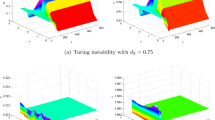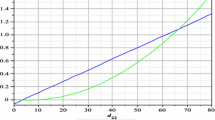Abstract
In this work, we unveiled some important aspects of a predator–prey system in a windy environment considering the herd geometry of prey species by constructing a mathematical model of the proposed system under consideration. As the first of the study, we have shown the positivity and boundedness property of the solutions of the modified new system. Analytical and numerical experiments exhibit the dependence of equilibrium biomass on the strength of wind and geometry of the herd shape. The existence of trans-critical and Hopf bifurcation has been observed for a smooth change in the windy environment. Sensitivity analysis has been carried out to explore the significant parameters that affect the predator population density. Moreover, we have studied the spatially extended system with a windy environment and herd behavior. The existence of Hopf bifurcation is proved in the system, theoretically and numerically. Turing patterns are not possible in the system; however, interesting non-Turing patterns are obtained for different herd behaviors in a windy environment. The resulting non-Turing patterns are irregular patchy chaotic patterns as corresponding chaotic spatial attractors obtained in the spatially extended system. Hence, the spatially extended system exhibits interesting spatiotemporal dynamics with a windy environment and herd behavior. These dynamics help better understand predator–prey interactions in a real environment.



























Similar content being viewed by others
Data Availibility Statement
Data sharing is not applicable to this article as no new data were created or analyzed in this study.
References
C.S. Holling, Some characteristics of simple types of predation and parasitism1. Can. Entomol. 91(7), 385–398 (1959)
J. Roy, D. Barman, S. Alam, Role of fear in a predator-prey system with ratio-dependent functional response in deterministic and stochastic environment. Biosystems 197, 104176 (2020)
J. Roy, S. Alam, Study on autonomous and nonautonomous version of a food chain model with intraspecific competition in top predator. Math. Methods Appl. Sci. 43(6), 3167–3184 (2020)
D. Barman, J. Roy, S. Alam, Impact of wind in the dynamics of prey-predator interactions. Math. Comput. Simul. 191, 49–81 (2022)
D. Barman, J. Roy, S. Alam, Modelling hiding behaviour in a predator-prey system by both integer order and fractional order derivatives. Ecol. Inform. 67, 101483 (2022)
V. Ajraldi, M. Pittavino, E. Venturino, Modeling herd behavior in population systems. Nonlinear Anal. Real World Appl. 12(4), 2319–2338 (2011)
A.R. Hayes, N.J. Huntly, Effects of wind on the behavior and call transmission of pikas (Ochotona princeps). J. Mammal. 86(5), 974–981 (2005)
P.G.C. Jakosalem, N.J. Collar, J.A. Gill, Habitat selection and conservation status of the endemic Ninox hawk-owl on Cebu, Philippines. Bird Conserv. Int. 23(3), 360–370 (2013)
E. Klimczuk, L. Halupka, B. Czyż, M. Borowiec, J.J. Nowakowski, H. Sztwiertnia, Factors driving variation in biparental incubation behaviour in the reed warbler Acrocephalus scirpaceus. Ardea 103(1), 51–59 (2015)
P. Stander, S. Albon, Hunting success of lions in a semi-arid environment, in: Symposia of the Zoological Society of London, Vol. 65, pp. 127–143 (1993)
M. McBlain, K. Jones, G. Shannon, Sleeping Eurasian oystercatchers adjust their vigilance in response to the behaviour of neighbours, human disturbance and environmental conditions. J. Zool. 312(2), 75–84 (2020)
M. Cherry, B. Barton, Effects of wind on predator-prey interactions. Food Webs 13, 92–97 (2017)
Y.-H. Law, A. Sediqi, Sticky substance on eggs improves predation success and substrate adhesion in newly hatched Zelus renardii (Hemiptera: Reduviidae) instars. Ann. Entomol. Soc. Am. 103(5), 771–774 (2010)
J. Turner, F. Vollrath, T. Hesselberg, Wind speed affects prey-catching behaviour in an orb web spider. Naturwissenschaften 98(12), 1063–1067 (2011)
J. Yasuoka, R. Levins, Ecology of vector mosquitoes in Sri Lanka-suggestions for future mosquito control in rice ecosystems. Southeast Asian J. Tropic. Med. Publ. Health 38(4), 646 (2007)
L.A. Calcaterra, S.D. Porter, J.A. Briano, Distribution and abundance of fire ant decapitating flies (Diptera: Phoridae: Pseudacteon) in three regions of southern South America. Ann. Entomol. Soc. Am. 98(1), 85–95 (2005)
P.J. Van Soest, Allometry and ecology of feeding behavior and digestive capacity in herbivores: a review. Zoo Biol. Publ. Affil. Am. Zoo Aquar. Assoc. 15(5), 455–479 (1996)
A.L. Thomas, G.K. Taylor, Animal flight dynamics i. stability in gliding flight. J. Theor. Biol. 212(3), 399–424 (2001)
A.B. Medvinsky, S.V. Petrovskii, I.A. Tikhonova, H. Malchow, B.-L. Li, Spatiotemporal complexity of plankton and fish dynamics. SIAM Rev. 44(3), 311–370 (2002)
K. Steinmüller, a. Okubo, Diffusion and ecological problems: Mathematical models.(biomathematics, vol. 10.) Springer-Verlag, Berlin-Heidelberg-New York 1980, 254 pp., 114 figs., 6 tab., dm 78.- (1982)
A. Okubo, S.A. Levin, The basics of diffusion, in Diffusion and Ecological Problems: Modern Perspectives. (Springer, Berlin, 2001), pp.10–30
H. Malchow, Spatiotemporal Patterns in Ecology and Epidemiology: Theory, Models, and Simulation (Chapman and Hall/CRC, Boca Raton, 2007)
A.M. Turing, The chemical basis of morphogenesis. Bull. Math. Biol. 52(1), 153–197 (1990)
L.A. Segel, J.L. Jackson, Dissipative structure: an explanation and an ecological example. J. Theor. Biol. 37(3), 545–559 (1972)
B. Dubey, N. Kumari, R.K. Upadhyay, Spatiotemporal pattern formation in a diffusive predator-prey system: an analytical approach. J. Appl. Math. Comput. 31(1), 413–432 (2009)
M. Banerjee, S. Banerjee, Turing instabilities and spatio-temporal chaos in ratio-dependent Holling-Tanner model. Math. Biosci. 236(1), 64–76 (2012)
N. Kumari, Pattern formation in spatially extended tritrophic food chain model systems: generalist versus specialist top predator, International Scholarly Research Notices 2013 (2013)
R.D. Parshad, N. Kumari, A.R. Kasimov, H.A. Abderrahmane, Turing patterns and long-time behavior in a three-species food-chain model. Math. Biosci. 254, 83–102 (2014)
M. Banerjee, Turing and non-Turing patterns in two-dimensional prey-predator models, in: Applications of Chaos and Nonlinear Dynamics in Science and Engineering-Vol. 4, Springer, pp. 257–280 (2015)
V. Kumar, N. Kumari, Bifurcation study and pattern formation analysis of a tritrophic food chain model with group defense and Ivlev-like nonmonotonic functional response. Chaos Solitons Fractals 147, 110964 (2021)
S. Batabyal, D. Jana, R.D. Parshad, A.A. Basheer, R.K. Upadhyay, Pattern formation in an explosive food chain model: the case of apparent mutualism. Eur. Phys. J. Plus 136(4), 1–28 (2021)
D. Jana, S. Batabyal, M. Lakshmanan, Self-diffusion-driven pattern formation in prey-predator system with complex habitat under fear effect. Eur. Phys. J. Plus 135(11), 1–42 (2020)
Y. Liu, X. Tao, Z. Zhang, L. Zhu, A study of the Turing pattern formation in a predator-prey model based on network and non-network environments. Eur. Phys. J. Plus 137(6), 691 (2022)
B.T. Mbopda, S. Issa, S. Abdoulkary, R. Guiem, H. Fouda, Pattern formations in nonlinear dynamics of hepatitis b virus. Eur. Phys. J. Plus 136(5), 1–15 (2021)
N. Kumari, V. Kumar, Controlling chaos and pattern formation study in a tritrophic food chain model with cannibalistic intermediate predator. Eur. Phys. J. Plus 137(3), 1–23 (2022)
V. Kumar, N. Kumari, Pattern formation study of Hassell-Varley prey-predator system with fear effect, in: AIP Conference Proceedings, Vol. 2435, AIP Publishing LLC, p. 020053 (2022)
R. Peng, J. Shi, M. Wang, Stationary pattern of a ratio-dependent food chain model with diffusion. SIAM J. Appl. Math. 67(5), 1479–1503 (2007)
T. Huang, H. Zhang, X. Cong, G. Pan, X. Zhang, Z. Liu, Exploring spatiotemporal complexity of a predator-prey system with migration and diffusion by a three-chain coupled map lattice, Complexity 2019 (2019)
M. Banerjee, L. Zhang, Time delay can enhance spatio-temporal chaos in a prey-predator model. Ecol. Complex. 27, 17–28 (2016)
M. Banerjee, S. Petrovskii, Self-organised spatial patterns and chaos in a ratio-dependent predator-prey system. Theor. Ecol. 4(1), 37–53 (2011)
M. Banerjee, Self-replication of spatial patterns in a ratio-dependent predator-prey model. Math. Comput. Modell. 51(1–2), 44–52 (2010)
W. Wang, Q.-X. Liu, Z. Jin, Spatiotemporal complexity of a ratio-dependent predator-prey system. Phys. Rev. E 75(5), 051913 (2007)
S. Yuan, C. Xu, T. Zhang, Spatial dynamics in a predator-prey model with herd behavior. Chaos Interdiscip. J. Nonlinear Sci. 23(3), 033102 (2013)
Y. Song, X. Tang, Stability, steady-state bifurcations, and Turing patterns in a predator-prey model with herd behavior and prey-taxis. Stud. Appl. Math. 139(3), 371–404 (2017)
T. Singh, S. Banerjee, Spatiotemporal model of a predator-prey system with herd behavior and quadratic mortality. Int. J. Bifurc. Chaos 29(04), 1950049 (2019)
S. Djilali, Pattern formation of a diffusive predator-prey model with herd behavior and nonlocal prey competition. Math. Methods Appl. Sci. 43(5), 2233–2250 (2020)
A. Batabyal, D. Jana, Significance of additional food to mutually interfering predator under herd behavior of prey on the stability of a spatio-temporal system. Commun. Nonlinear Sci. Numer. Simul. 93, 105480 (2021)
B. Chakraborty, H. Baek, N. Bairagi, Diffusion-induced regular and chaotic patterns in a ratio-dependent predator-prey model with fear factor and prey refuge. Chaos Interdiscip. J. Nonlinear Sci. 31(3), 033128 (2021)
S.-N. Chow, J.K. Hale, Methods of Bifurcation Theory, vol. 251 (Springer Science & Business Media, Berlin, 2012)
S. M. Blower, H. Dowlatabadi, Sensitivity and uncertainty analysis of complex models of disease transmission: an HIV model, as an example, International Statistical Review/Revue Internationale de Statistique 229–243 (1994)
S. Marino, I.B. Hogue, C.J. Ray, D.E. Kirschner, A methodology for performing global uncertainty and sensitivity analysis in systems biology. J. Theor. Biol. 254(1), 178–196 (2008)
S. Djilali, Impact of prey herd shape on the predator-prey interaction. Chaos Solitons Fractals 120, 139–148 (2019)
S. Ghorai, S. Poria, Pattern formation and control of spatiotemporal chaos in a reaction diffusion prey-predator system supplying additional food. Chaos Solitons Fractals 85, 57–67 (2016)
A. J. Belsky, Population and community processes in a mosaic grassland in the Serengeti, Tanzania, J. Ecol. 841–856 (1986)
A. Morozov, S. Petrovskii, Excitable population dynamics, biological control failure, and spatiotemporal pattern formation in a model ecosystem. Bull. Math. Biol. 71(4), 863–887 (2009)
Acknowledgements
The authors would like to thank the editor and anonymous reviewers for their helpful comments, which improved the quality of this paper greatly.
Author information
Authors and Affiliations
Corresponding author
Ethics declarations
Conflict of interest
The authors have no conflicts to disclose.
Rights and permissions
Springer Nature or its licensor holds exclusive rights to this article under a publishing agreement with the author(s) or other rightsholder(s); author self-archiving of the accepted manuscript version of this article is solely governed by the terms of such publishing agreement and applicable law.
About this article
Cite this article
Barman, D., Kumar, V., Roy, J. et al. Modeling wind effect and herd behavior in a predator–prey system with spatiotemporal dynamics. Eur. Phys. J. Plus 137, 950 (2022). https://doi.org/10.1140/epjp/s13360-022-03133-4
Received:
Accepted:
Published:
DOI: https://doi.org/10.1140/epjp/s13360-022-03133-4




